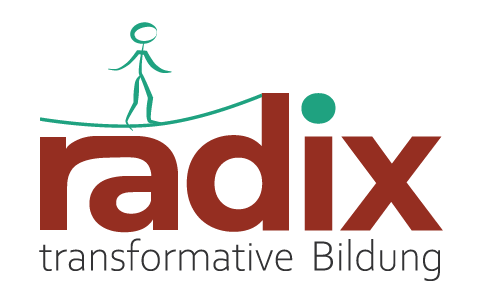Queer Across the World
Through a text puzzle, participants learn about the global connections between gender justice and climate justice.
Learning Objectives
Participants…
- recognize and reflect on fundamental connections between climate and queerness in the context of global justice.
- reflect on structural discrimination and how queer communities are affected by the climate crisis.
- learn about examples of initiatives, individuals, and organizations advocating for global queer climate justice.
Process
Preparation
For preparation, the following blog post is read:
Neuffer, C. (2024, November 28). The sea levels are rising and so are we. Konzeptwerk Neue Ökonomie. Retrieved January 22, 2025, from https://konzeptwerk-neue-oekonomie.org/the-sea-levels-are-rising-so-are-we/
The facilitator should also read the puzzle cards (example cards and information cards), the solutions and the glossary beforehand. Depending on the desired difficulty level, the facilitator can decide how many puzzle card pairs to use. Using eight pairs is recommended as the standard. Keep in mind that the number of puzzle cards affects the game duration—more card pairs will require more time. The puzzle cards should be printed and cut out, and the glossary printed. Each group of four participants will need one puzzle card set and one glossary.
Implementation
- Introduction (10 minutes)
The facilitator introduces the topic, emphasizing the link between climate justice and the rights and empowerment of queer people. They explain the method’s process and the task for group work. The facilitator also notes that the method addresses explicit experiences of discrimination (see the content note under Tips for Facilitators). - Puzzle (20 minutes)
Participants divide into groups of four. Each group receives one puzzle card set and one glossary. Within the groups, two participants take the information cards, while the other two take the example cards. One team reads a card aloud, and the other team matches one of their cards by reading it and deciding which card fits best. The teams then switch roles: the matching team reads a new card aloud, and the other team matches one of their own cards. The game continues until all cards are matched. - Group Exchange (10 minutes)
All participants move to a different table where another group has worked, so newly mixed groups sit together. The puzzles remain on the tables. The new groups review the puzzle at their table and compare it with the puzzle their original groups completed. If there are differences, they discuss and, if needed, rearrange some cards. - Debrief (20 minutes)
In a larger group discussion, the following questions are addressed:
- How did it feel to find matching cards?
- What was new or interesting for you?
- How do you feel about the new information?
- In what ways are queer communities particularly affected by the climate crisis?
- What are the reasons why queer communities are, on average, more affected by the climate crisis?
- What happens in queer climate justice activism? Do you know any examples?
- What does this quote mean to you, in relation to the puzzle and the topic? What connections do you see?
“There is no such thing as a single-issue struggle because we do not live single-issue lives” – Audre Lorde, a renowned poet, feminist, and civil rights activist.
(Lorde, A. (1984). Sister Outsider: Essays and Speeches. Crossing Press.)
Tips and Notes for Facilitators
- Glossary: A glossary with specific terms from the field is available. It helps the facilitator prepare thoroughly by reviewing the glossary and background text.
- Sensitivity to Discrimination and Power Dynamics: The facilitator should be aware of the different positions participants may hold in the group and address this sensitively. Pay attention to possible power dynamics and ensure that discriminatory statements or behaviors are not tolerated. If FLINTA* people (see Glossary) or other marginalized groups speak less, address this actively without making assumptions about gender identities.
- Content Note: This method addresses explicit experiences of discrimination and violence against LGBTQIA* people. Some cards contain discriminatory statements cited from real people. Inform participants about this content in advance and give them the option to prepare themselves or leave the room if necessary. Emphasize that there will be space for solidarity and support within the group. During the debrief, ensure the empowering examples are given enough attention to avoid a sense of helplessness or despair.
- Intersectionality (see Glossary) and Media Reflection: Highlight how queerphobia affects people who are also impacted by other forms of discrimination and how the climate crisis amplifies these effects. Incorporate current debates, especially when queer and climate activists are turned into scapegoats by the media.
Downloadable Materials
- Puzzle Cards
- Solutions
- Glossary
Sources and Further Reading
Great educational material for further work on climate and gender justice has been created by the collective Bildung für utopischen Wandel (http://buwa-kollektiv.de/). Their handbook KlimaQUEERechtigkeit provides facilitators with various methods and background information for educational work in this field:
Bildung für utopischen Wandel e.V. (2023). KlimaQUEERechtigkeit: Queerfeminismus und Klimagerechtigkeit zusammengedacht – Materialien für die Bildungsarbeit. https://buwa-kollektiv.de/materialien/methoden/klimaqueerechtigkeit/
Further examples of queer activism for inspiration for additional educational units can be found in the BUND youth brochure on the climate crisis and colonialism:
BUNDjugend. (2021, December). Kolonialismus und Klimakrise: Über 500 Jahre Widerstand. https://www.bundjugend.de/wp-content/uploads/2024/09/kolonialismus_und_klimakrise-ueber_500_jahre_widerstand-2.pdf

